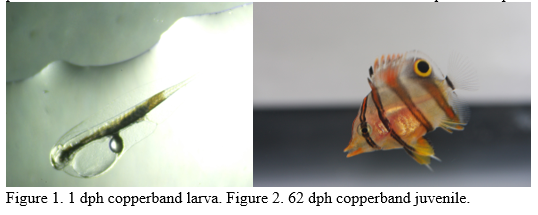FIRST SUCCESSFUL CAPTIVE SPAWNING AND LARVAL CULTURE OF THE COPPERBAND BUTTERFLYFISH Chelmon rostratus
The copperband butterflyfish is a popular saltwater aquarium fish and is only available from wild collection . W ild specimens are commonly collected but are fragile and difficult to transition to artificial feeds. Thus development of captive culture methods is justified. This presentation will document the first successful captive spawning and culture of copperband butterflyfish larvae to the juvenile stage.
Copperband butterflyfish form monogamous pairs that spawn pelagic eggs. The eggs were collected using a surface skimmer made with 500 µm mesh. Eggs were harvested in the morning and quantified before being stocked into 29 L tanks.
The newly hatched prolarvae were 2 mm total length and lacked pigmented eyes and mouths. The larvae were robust and transitioned to exogenous feeding around 3 dph and were fed exclusively copepod nauplii Parvocalanus crassirostris for 50 days . At 10 dph , the larvae began to develop characteristics of the tholichthys stage; long spikes formed on the edge of the operculum and bony head plates began to form. Flexion occurred at 20 dph . Around day 38, incidental adult copepods that had escaped predation and matured in the tank began to disappear from the water column as the larvae continued to grow. The transition from tholichthys to settlement occurred rapidly around day 51 post hatch, when the first striped larva was identified. Artemia nauplii were introduced around 60 dph. The successful settlement of this species represents a significant step for ornamental aquaculture and the scientific community. Documenting this species' embryo and larval developmental and first successful culture protocols sets the foundation for future research and commercial aquaculture production efforts.
